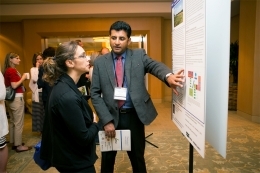
Name
Siddhartha "Sid" Thakur, B.V.Sc, M.V.Sc,Ph.D.
Title
Associate Professor, Molecular Epidemiology
Institution
North Carolina State University
Education
Ph.D., Population Medicine, North Carolina State University
M.V.Sc., Veterinary Science in Veterinary Public Health, Indian Veterinary Research Institute
B.V.Sc., Veterinary Science and Animal Husbandry, Gobind Ballabh Pant University of Agriculture and Technology
What brought you to North Carolina State University?
I got my first degree in veterinary science and a Master’s in veterinary public health from India. I came to NCSU to do my Ph.D. on multi-drug resistant Campylobacter in pigs. After finishing my work, I joined the Center for Veterinary Medicine at the FDA in Maryland, working with the National Antimicrobial Resistance Monitoring System as an Oak Ridge research fellow for two years. I came back to NC State’s college of veterinary medicine in 2007 as an assistant professor, and I joined the swine health and reproduction faculty. One of the reasons I wanted to come back to North Carolina is because it’s very big in agriculture, and I’m not talking just food-animal agriculture, but also fresh produce. Besides, it has nice weather and nice people, and I love NC State University.
What influenced you to enter the field of food safety?
When I look at food safety, I’m looking not just at fresh produce, but also at retail meat. A lot of my interest came from when I worked at FDA. They’re responsible for generating the antimicrobial resistance data for different pathogens isolated from retail meats. I got into fresh produce safety in an indirect way. When I was working with the swine and pig industry, I also did a lot of work with outdoor swine producers in North Carolina who had backyard pigs. I noticed that while they’re raising pigs, they’re also growing a lot of crops, like corn, for example. And, that’s probably not safe because of the presence of pathogens in the environment. So, I got interested in fresh produce safety looking at it more from the animal side.
How did you learn about the Center for Produce Safety?
I was getting more and more interested in the interface between animals and fresh produce. When I looked online and talked to my colleagues from the fresh produce safety side, I found CPS. My first reaction was that I should be involved – it sounds like a good center and they provide a good amount of funding for research on produce safety.
Why did you apply for funding from CPS?
One of the most important reasons is that I knew if I got funded by CPS, it’s a very distinguished grant. I know a lot of people apply for these grants, and they’re not successful. I was successful in the third year, and it was a learning process for me. CPS is the leader in the area of produce safety. When you go to their annual meetings, it’s basically the who’s who of food safety in fresh produce in the U.S. and probably the world and you’re talking to these people. So, it’s a great platform. I can contact anybody I meet there, and they’re very happy to help me out because the basic mission is produce safety.
In 2014 CPS funded your project, “Food Safety Risks at the Fresh Produce-animal Interface: Identifying Pathogen Sources and Their Movement on Diversified Farms.”
What do you hope to accomplish?
My hope is to learn a couple of things. First, can we really say there’s a well-defined buffer zone of X number of feet away from a source of infection for fresh produce? Can we really define that distance? How did we come up with 400 feet? Why is it not 450 feet, for example? Second, we want to find out more about these smallish farms – the focus has always been on bigger farms. My thought process was that whether a spinach outbreak is on a big farm or a small farm, the way the media is and how fast news spreads on the Internet, it’s going to devastate the entire spinach industry regardless. So, what can we do to educate these small-scale sustainable farmers about how they can make their end-products safer for consumption?
Where do you see the field of food safety research five years down the road? Why?
We are learning so many new things, and the science is really enriching us. So, I see that five years from now, food safety research is really going to expand. My hope and understanding is that fresh produce will be safer because of the work that the different researchers are doing in this area. I’m very comfortable about the next five years.
Aside from working in the laboratory, how else to you spend your time?
My wife is also a faculty member at NC State, so we have a busy, busy schedule. We have two lovely kids, and I spend as much time as I can with my kids. My son is nine, and my daughter is six, and they keep me busy. Plus, I like to play tennis and cricket when I get some spare time.
Describe one or more of your career highlights
In 2012, I received the Larry Beuchat Young Researcher Award from the International Association for Food Protection. That’s one of the premiere food safety-food protection associations, so that award was very prestigious to me. This year, I was recognized as one of the Chancellors University Faculty Scholars at NC State. Your college nominates you for this award, which in itself is very significant. I believe we have 2,500 faculty at the university level, and they select 10 to 15 faculty for recognition every year. And, you get to carry this title for the next five years. It was a real honor for me to see that my work has been appreciated by my peers and my colleagues.